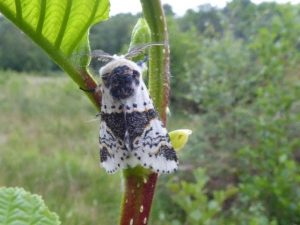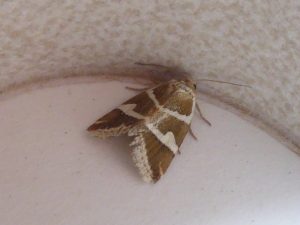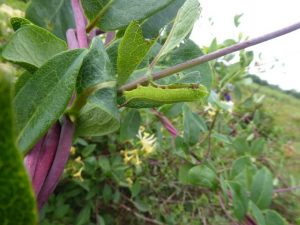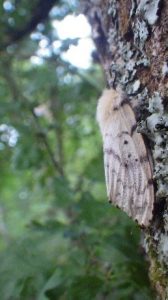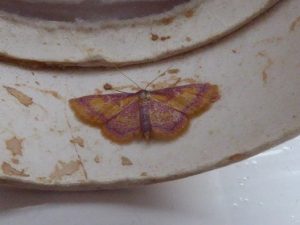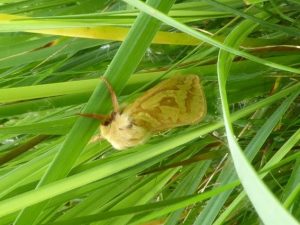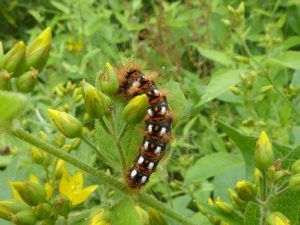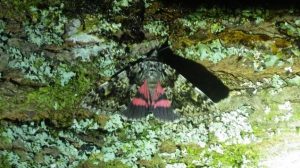Mike Halsey and his team have been monitoring the moths found on the Reserve. Here he writes on their progress.
After a successful 2022, there were high expectations of further exciting finds at the reserve in spring and early summer 2023.
Sadly, the late spring weather made it hard to get out much, but things improved in the second half of May with some warmth and dry evenings and nights. Late May to early July is generally a highly productive part of the year for moths, and this year we’ve had some very exciting finds over this period.
One of the hoped-for species since starting the current survey was the Alder Kitten which, before 2023, had only been seen once in Hampshire, and that was back in 1945! Despite the site seemingly ticking all the right boxes in terms of appropriate habitat, we didn’t encounter it last year. On 10th June 2023, however, it was exciting finally to see a specimen at the pond (pictured below).
On the same evening, we saw a specimen of the Silver-Barred moth (pictured below), known as a UK resident only from the Cambridge fens and a coastal Kentish Marsh. More work is needed to confirm its status here in Fleet, but exciting to think it’s almost certainly resident here.
From late May to late June, the Broad-bordered Bee Hawk moth flies by day, feeding at various flowers (including honeysuckle, buddleia and rhododendron), the female laying eggs on honeysuckle leaves. The adult moth is a bee mimic and not often seen; however when the eggs hatch, the small larvae leave unmistakable signs of their presence by nibbling a series of tiny holes in leaves. These feeding signs (pictured left below), and some of the larvae themselves (pictured right below), have been found this year at many places across the reserve, it’s great to see a moth like this have such a stronghold here.
Another family of day-flying moths is the ‘clearwings’, all of which are exceptional wasp or hornet mimics. The UK has 16 resident species in this family, we’ve now seen nine at the reserve. One of the species newly seen this year is the six-belted clearwing (pictured below), the larvae of which feed on the roots of Bird’s-foot trefoil.
Also feeding Bird’s-foot trefoil – the leaves this time – is a tiny silver moth (wingspan 5-6mm!) going by the name of Leucoptera lotella. Rarely seen in this part of the county (or at all really – no doubt overlooked on account of its size) it was lovely to come across this in mid-July; sadly I don’t have a good photo of this to share. Between this, the Silver-barred, the Dotted fan-foot (Nationally scarce but with a strong base here in Fleet) and many others, Fugelmere Marsh – with its array of rare marsh plants – is turning out to be a critically important reserve for Lepidoptera (and no doubt other invertebrate orders).
A lot has been written about the impact of climate change on invertebrate populations and we really do see this on a practical level with moths, with continental species gradually moving north and establishing populations in the UK.
The Gypsy Moth is a recent example of this; adults can often now be seen around the pond (the darkly coloured male is another day-flying species, often mistaken for a quick-flying butterfly) – pictured below is a female reared from a caterpillar found at the end of April, proving that the moth is breeding at the reserve.
Finally, to dispel the thought that moths are all drab, brown or grey, a final grab bag of photos from this year below include: (pictured below) a Purple-bordered gold, a Nationally Scarce insect which relies on Marsh Cinquefoil.
(Pictured above) a female Ghost swift – these large moths with a wingspan of up to nearly 5cm can be seen flying slowly over grassy areas around dusk in June. They are one of very few moths to ‘spray’ their eggs while in flight, as opposed to fixing them to the larval food plant.
Pictured above a Knotgrass larva feeding on Yellow Loosestrife, one of the valuable marsh plants that supports a wide range of insects.
The ‘Underwing season’ is now firmly with us (crimson underwing, pictured above, photographed on 13th July), and if you’re keen to join in one evening to look for these magnificent insects, please contact the Society Secretary at secretary@fleetpond.org.uk
Photo credits: Six-belted clearwing, cropped from an image taken by Ana Piero; all other photos – Mike Halsey.

